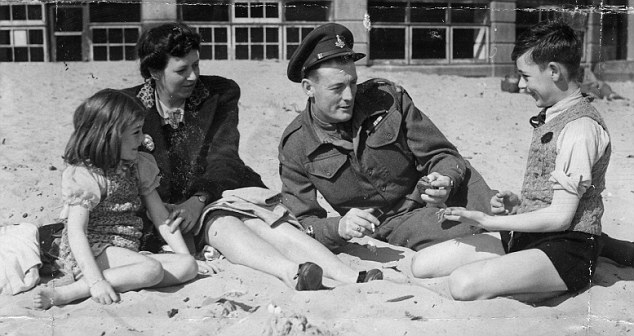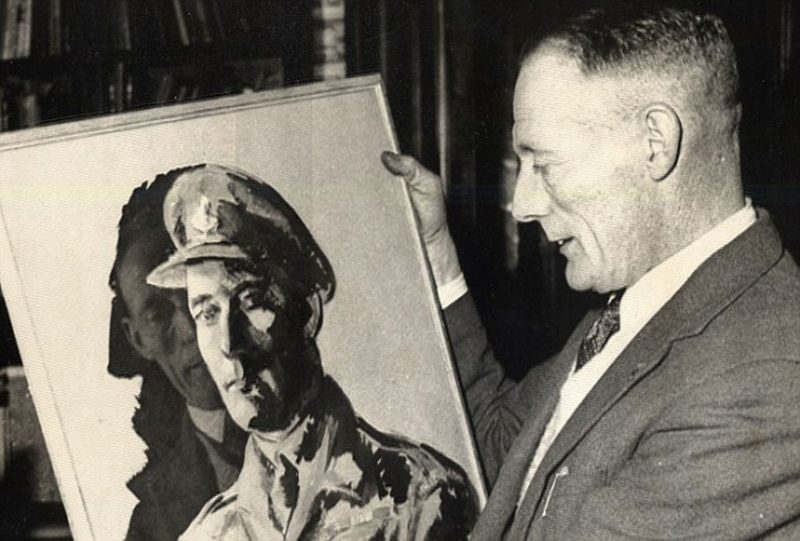Hollis was appointed Company Sergeant Major just before the invasion of Sicily in 1943 where he was wounded at the battle of Primosole Bridge
But he’s well aware his 6ft 2in mountain of a dad was not infallible and he becomes emotional as he imagines the real fear and horror he must have faced. “When he came back he was quiet, he didn’t brag. People would come up and congratulate him but he didn’t like it. People learnt not to question him. He turned away journalists. He just wanted to get back to normal,” he remembers.
“When I listen to the stories now it is upsetting. To think what he must have gone through. He must have been very frightened.”
And of course he was – but that fear didn’t stop him.
He was recommended for the VC twice. First he broke away from his men and charged full pelt at a pill box manned by Germans firing machine guns indiscriminately, to protect his comrades. He dodged the rounds of ammunition and got so close he could fire point blank through the slit, killing the enemy inside. Then he thrust in a grenade, scaring the remaining enemy troops into surrender and taking 20 prisoners.
Just hours later, he alone went back to an occupied farmhouse where two of his comrades were under fire, and ran at a hedge full of Germans with his single gun, braving their bullets so his men could flee. The bullets in his feet remained there for the rest of his life and would bleed as he stood and served behind the bar of the pub he went on to own after the war.
In explanation, he only said: “All these fellers were my mates.” And modest Stan later wrote in his short memoirs of his exploits on June 6, 1944: “There wasn’t only me doing these things, there was other people doing things as well. And the things that I did, if I hadn’t done them, somebody else would have.”
In many ways, it was when he was home that Stan struggled more to emotionally come to terms with what he had experienced. Brian admits he suffered bouts of ‘depression’.
His biographer Mike Morgan reveals more. Although Stan was a man to be reckoned with, and never lost a fight – he was regularly challenged by locals back home keen to prove their worth against a VC recipient, and walked away unruffled – he struggled mentally.
Mr Hollis and his family on a beach. He was haunted by some of the things he had seen and done during combat
“He would have depressive episodes and sometimes lock himself away,” Mike admits. “For days he would stay in his room and push money under the door for the family. Then he would come out and carry on as normal.
“One incident really played on his mind. He had to kill a 16-year-old lad, a member of the Hitler Youth. It hit him hard.
“He killed 102 soldiers during the war but to kill a boy got to him. It happened when they were pushing inland after D-Day. Initially they treated him well because he was so young, but then one day he picked up a gun and shot a couple of Stan’s comrades and killed them. So he had to shoot him. He was a family man, his own son wasn’t much younger.”
Stan’s beginnings didn’t immediately point to decoration at the palace.
The son of a Teesside labourer who later became a fishmonger, he ran away to sea numerous times before his father apprenticed him to the navy at 17. But his career came to a quick end when he caught blackwater fever and the ongoing chest problems which forced him to leave.
His health didn’t stop him from joining the army when war was declared. He enlisted with the 4th Battalion, the Green Howards but was refused a commission to become an officer because of his lack of education.
Although Mike describes him as a ‘fiery, strong-willed lad’ who would get into trouble with his superiors for sneaking home to visit his wife Alice, he quickly won approval. Even before D-Day he fought with distinction in Sicily and Tunisia.
In his memoir Stan describes his preparations for D-Day. He recalled training in Inveraray, Scotland, before being brought down to a secret holding camp in Winchester before the launch.
“We were shown aerial photographs,” he wrote. “Yards and yards of them, of the whole area of Gold Beach…
“At reveille on the morning of D-Day we arrived about six miles off the beaches. We were on a ship called the Empire Lance. Reveille was about 2.30am to 3am. After having our breakfast – those who wanted it – we spent the rest of our time until we got into the landing craft loading it with ammunition which had to be carried up by the men to the high water mark and dropped on the beach for the follow-up troops.”
Then they cast off into the rough sea, 18 men to a boat.
Looking at his own portrait. He was a humble man who hated the fame his bravery gave him
It took an hour to get to shore. There, all hell let loose. Stan writes: “Everything in the world opened up from behind us. “There were 25-pounders firing off floating platforms, floating platforms firing thousands of rockets in one salvo, cruisers, destroyers, battleships, everything opened up on the shore…”
Stan describes a tank blowing up in front of him, and a German aircraft opening an attack above them.
It was through this chaos he charged the pill box, seeing his men falling like dominoes. “I rushed at it, spraying it hosepipe fashion,” he wrote, simply. “They fired back at me and they missed. I don’t know whether they were more panic-stricken than me – but they must have been.”
His later act, which led to his second recommendation for the VC, is described even more modestly. “Well, I took them in, I’ll go and try and get them out,” he said. Modesty remained with Stan until the end. Brian says he received his VC with pride as Doodlebugs flew over London in 1945. But back in Middlesbrough, Stan’s decision not to speak about his heroics and to live a quiet life meant he became one of the lesser-known heroes in history.
“He just wanted to be a dad and granddad,” says Brian, who has a sister, Pauline.
Stan died in 1972 aged 59. It is only now that his home town finally plans to erect a statue of him, later this year.
“He was up there with Guy Gibson, he should have been one of the best known soldiers of the war,” says Mike. But like father like son, Brian explains: “Dad wouldn’t have liked the fuss.”
Citation
Hollis was 31 years old, and a Warrant Officer Class II (Company Sergeant-Major) in the 6th Battalion, The Green Howards, British Army during the Second World War when the following deed took place for which he was awarded the VC:
| “ | In Normandy on 6 June 1944 Company Sergeant-Major Hollis went with his company commander to investigate two German pill-boxes which had been by-passed as the company moved inland from the beaches. “Hollis instantly rushed straight at the pillbox, firing his Sten gun into the first pill-box, He jumped on top of the pillbox, re-charged his magazine, threw a grenade in through the door and fired his Sten gun into it, killing two Germans and taking the remainder prisoners.Later the same day… C.S.M. Hollis pushed right forward to engage the [field] gun with a PIAT [anti-tank weapon] from a house at 50 yards range… He later found that two of his men had stayed behind in the house…In full view of, the enemy who were continually firing at him, he went forward alone…distract their attention from the other men. Under cover of his diversion, the two men were able to get back. Wherever the fighting was heaviest…[he]…appeared, displaying the utmost gallantry… It was largely through his heroism and resource that the Company’s objectives were gained and casualties were not heavier. ….he saved the lives of many of his men. |


No comments:
Post a Comment